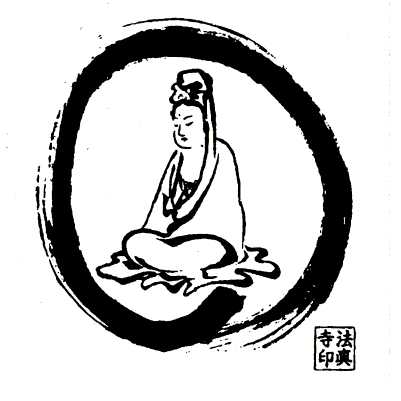
Shobogenzo Zazengi (1)
[The Way of Zazen]
Eihei Dogen Zenji
Sanzen
(2) is zazen.
A quiet place is most
suitable for doing zazen. Place a thick mat on the floor. Do not allow drafts
or mist to enter the room. Do riot allow rain or dew to leak in. Protect the place
where you sit; keep it in good condition. Ancient sages sat on the diamond seat
(3) or on a large rock. They all laid grass
thickly and sat on it. Keep the place where you sit well-lit. It should be dark
neither during the day nor at night. It is essential that it be warm in winter
and cool in summer.
Let go of all relations, and set all affairs at rest.
Being good is not-thinking; being evil is not-thinking. Zazen has nothing to do
with the function of intellect, volition, or consciousness, nor with memory, imagination,
or contemplation. Do not seek to become a buddha. Be free from the discrimination
of sitting and lying down. Be moderate in drinking and eating. Do not squander
your time. Be as eager to do zazen as you would be to extinguish a fire upon your
head. The fifth patriarch on Mt. Obai (4)
practiced nothing but zazen.
When you do zazen, wear a kesa (5),
and use a cushion. The cushion should not extend completely under your legs, but
should be placed just under your buttocks, so that your legs are on the mat, and
your spine is on the cushion. This is the way that the buddhas and patriarchs
sit when they do zazen.
You may sit in either half-lotus or full-lotus.
When you sit in full-lotus, put your right foot on your left thigh, and put your
left foot on your right thigh. The line of your toes should be even with the outer
line of your thighs. When you sit in half-lotus, just put your left foot on your
right thigh. Keep your clothing loose, but neat. Put your right hand palm up on
your left foot. And your left hand palm up on your right palm. The tips of your
thumbs should be lightly touching. Position both your hands as above, and put
them close to your body. The tips of your thumbs should be just in front of your
navel.
Sit upright in the proper position. Lean neither to the left nor to
the right, neither forward nor backward.
Your ears should be in line
with your shoulders; your nose in line with your navel. Place your tongue against
the roof of your mouth. Breathe through your nose. Your lips and jaw should be
closed. Keep your eyes open, but neither too widely nor too narrowly. Adjust your
body and mind in this way; then exhale fully and take a breath.
Sit stably
in samadhi. Think of not-thinking. How do you think of not-thinking? Beyond-thinking.
This is the way (6) of doing zazen in
accord with the dharma.
Zazen is not learning (step-by-step) meditation.
Rather zazen itself is the dharma-gate of great peace and joy (nirvana). It is
undefiled practice-enlightenment.
Shobogenzo Zazengi, the eleventh volume.
In the eleventh month of the first
year of Kangen (1243), delivered at Esshu Yoshida-gun, Yoshimine-shoia (7).
Notes
to Shobogenzo Zazengi
(1) This
is one of the volumes of Shobogenzo. While Fukan-zazengi is written in Chinese,
this Zazengi is written in Japanese.
(2)
Sanzen usually means to visit a master and practice with him, or to have a personal
interview with the teacher. According to Dogen Zenji, however, sanzen is sitting
zazen itself.
(3) This is a reference to
the place under the bodhi-tree, where Sakyamuni-Buddha sat when he completed the
Way. The diamond is a symbol of that which is eternal, most valuable and unbreakable,
that is, Reality.
(4) Mt. Obai (Huang mei)
is where the monastery of the fifth patriarch Konin (Hongren 688-761) was located.
Dogen Zenji's reference to him is intended to indicate that just sitting is the
fundamental practice. The fifth patriarch represents the time before the division
of Zen into Northern and Southern, Soto and Rinzai, etc.
(5)
Kasaya in Sanskrit. A surplice which Buddhist monks wear over their other robes.
It symbolizes the Buddha’s robe.
(6)
The original word Dogen used is inmo (nemo) which literally means “thus”
or “how”. In Chinese Zen, this word is used for pointing out Reality
as a whole which cannot be defined.
(7)
This is the name of the temple where Dogen Zenji and his sangha stayed for about
a year while Eiheiji was under construction.
Dogen Zenji (1200-1253) is the founder of Japanese Soto Zen. Son of a government minister, Koga Michichika, he lost his parents when he was young, and became a monk at the age of thirteen at Mt. Hiei. Later he practiced Zen under Myozen, who was a disciple of Zen master Eisai, at Ken ninji.
Dogen went to China with Myozen at the age of 24. He received dharma transmission from Tendo Nyojo (Tiantong Rujing) and returned to Japan at the age of 28. He lived in Kenninji for a few years and later founded Kashoji, which is the first real Zen monastery in japan. In 1243, he moved to Echizen (presently Fukui Prefecture) and founded Daibutsuji which was later renamed Eiheiji. Even today Eiheiji serves as the center of Soto Zen. He died at the age of 54. Dogen Zenji is respected as one of the greatest figures in the history of Japanese Buddhism.
From:
Shikantaza - an introduction to Zazen
Edited and translated by Shohaku Okumura
Kyoto Soto-Zen Center, 1985
Read On Zazen by Uchiyama Kosho Roshi.
Back to English Summary.
home | wat is zazen? | citaat van de week | vorige citaten | adressen en links | meer links